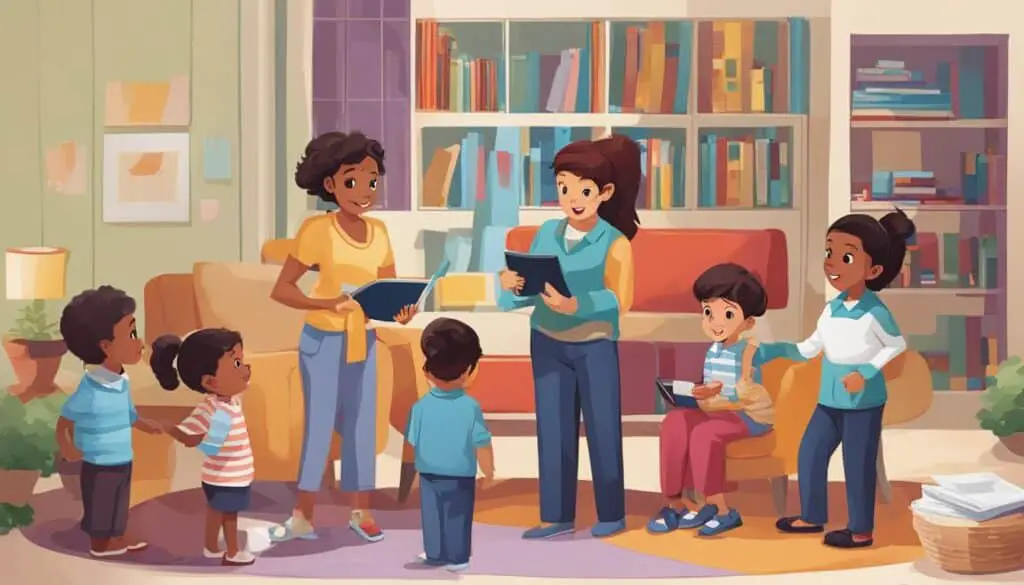
Strategies for Healthy Family Communication
Effective strategies for healthy family communication are essential for building strong, harmonious relationships within the household. When families communicate effectively, it enhances understanding, trust, and connection among family members. In this article, I will explore some strategies that can help improve family communication and create a nurturing environment for everyone.
Key Takeaways:
- Maintain open and uninterrupted communication by making time for meaningful conversations without distractions.
- Be a good listener and show empathy towards each other’s feelings.
- Lead by example by using positive words and tones in your communication.
- Give clear directions and praise your child’s efforts to encourage effective communication.
- Express your own feelings calmly and allow others to express theirs without judgment.
Importance of Healthy Communication in Families
Healthy communication plays a vital role in strengthening family relationships. When we communicate effectively within our families, we are able to connect on a deeper level, build trust and respect, and handle conflicts in a positive manner.
Effective communication allows us to understand each other better and create a support system during difficult times. It provides a safe space for everyone to express their thoughts and feelings, fostering a nurturing environment where open dialogue is encouraged.
According to Espyr, good communication skills in the family have numerous benefits:
- Improved ability to connect with family members
- Building trust and respect
- Resolving conflicts in a positive manner
- Enhanced understanding of individual needs
- Creating a support system during challenging times
By prioritizing healthy communication within the family, we can strengthen our bonds and create an atmosphere of trust, empathy, and collaboration. This not only improves the quality of our relationships but also helps us navigate through life’s challenges together.
“Effective communication is the glue that holds families together.”
To illustrate the importance of healthy communication in families, consider the following scenarios:
| Scenario | Negative communication approach | Positive communication approach |
|---|---|---|
| Conflicting schedules | Yelling and blaming | Scheduling a family meeting to discuss conflicts and find solutions |
| Disagreement between siblings | Ignoring each other and holding grudges | Listening to each other’s perspectives and finding a compromise |
| Challenging behavior from a child | Punishing without understanding the underlying issues | Engaging in open dialogue, addressing concerns, and offering support |
As seen in the table, healthy communication leads to positive outcomes, fostering understanding, cooperation, and problem-solving within the family dynamic.
Common Challenges in Family Communication
Effective family communication can face various challenges that hinder its success. These challenges can arise due to different factors, including upbringing, emotional barriers, and interpersonal dynamics. It is important to identify and address these challenges in order to foster healthy and open communication within the family.
1. Lack of Encouragement and Difficulties in Communication
Some individuals may struggle with expressing their thoughts and feelings due to a lack of encouragement or support during their upbringing. This can lead to hesitations in sharing emotions or effective communication.
2. Emotional Communication Barriers
Others may find it difficult to communicate without getting angry or upset, resulting in unconstructive conversations. Emotional barriers can hinder effective dialogue and prevent the understanding of each other’s perspectives.
3. Poor Listening Skills
Listening is a crucial part of communication, but some people may have trouble truly listening to others. This can create misunderstandings and a lack of validation, where family members may not feel heard or understood by one another.
4. Lack of Learned Communication Skills
Effective communication is a learned skill, and the absence of proper learning and development can contribute to communication barriers within families. Without the necessary communication skills, it becomes challenging to convey thoughts, emotions, and needs effectively.
“Communication is the fuel that keeps the fire of your relationship burning, without it, your relationship goes cold.” – William Paisley
Overcoming these challenges requires proactive effort and a commitment to improving family communication. By recognizing these issues and implementing strategies to address them, families can create an environment that fosters open dialogue, trust, and understanding.

| Challenges | Effects | Solutions |
|---|---|---|
| Lack of Encouragement and Difficulties in Communication | Difficulty expressing thoughts and feelings | Encourage open communication, provide support and validation |
| Emotional Communication Barriers | Unconstructive conversations and misunderstandings | Develop emotional intelligence, practice active listening |
| Poor Listening Skills | Lack of understanding and validation | Teach and practice active listening techniques |
| Lack of Learned Communication Skills | Ineffective conveying of thoughts, emotions, and needs | Invest in communication skills development, seek professional support |
Different Types of Communication
Effective communication is essential for building strong relationships within families. Understanding the different types of communication can help improve family dynamics and foster a healthy environment for open dialogue. In this section, I will explore the four main types of communication: verbal, nonverbal, written, and emotional.
Verbal Communication
Verbal communication involves the exchange of words through spoken language. It is the most common form of communication and encompasses conversations, discussions, and vocal expressions. Verbal communication allows individuals to convey information, express thoughts, and engage in meaningful dialogue with family members. It forms the foundation of effective communication within families, enabling everyone to understand and be understood.
Nonverbal Communication
Nonverbal communication refers to the transmission of messages without the use of words. It includes body language, gestures, facial expressions, and tone of voice. Nonverbal cues often convey emotions, attitudes, and intentions, complementing verbal communication and providing additional context to the spoken words. Recognizing and interpreting nonverbal cues is crucial for understanding the true meaning behind a family member’s words and fostering empathetic connections.

Written Communication
Written communication involves the exchange of information through written words. It can take various forms, such as emails, text messages, letters, or notes. Written communication allows individuals to communicate asynchronously, meaning the message can be sent and received at different times. This form of communication is particularly useful for expressing complex ideas, providing detailed instructions, or documenting important information within the family.
Emotional Communication
Emotional communication revolves around expressing feelings and emotions either verbally or through nonverbal cues. It encompasses empathy, active listening, and understanding each other’s emotional state. Emotional communication enables family members to connect on a deeper level, share their joys and sorrows, and offer support during challenging times. It strengthens emotional bonds and fosters a nurturing and understanding environment within the family.
Understanding the different types of communication empowers families to effectively express themselves, foster understanding, and build stronger relationships. By embracing all forms of communication, families can create a supportive and harmonious environment where thoughts, emotions, and ideas are freely shared.
Techniques for Improving Family Communication
Improving family communication is essential for fostering healthier relationships and creating a harmonious household. By implementing effective techniques, you can enhance communication dynamics within your family. Here are some valuable techniques to consider:
- Be a good role model: Lead by example and communicate respectfully. Show your family members how to express themselves in a kind, considerate manner.
- Active listening: Pay close attention to what your loved ones are saying. Demonstrate genuine interest by maintaining eye contact, nodding, and asking clarifying questions.
- Use “I” statements: When expressing your feelings or concerns, use “I” statements instead of “you” statements. This approach helps to avoid blame and promotes understanding.
- Practice assertive communication: Be clear and respectful in your communication, while also expressing your thoughts and feelings honestly. Avoid dominating the conversation or trying to control the other person’s responses.
- Body language and tone of voice: Remember that nonverbal cues can communicate as much as words. Pay attention to your body language and tone of voice to ensure your feelings are conveyed accurately.
- Initiate conversations: Take the initiative to start conversations with your family members. Share personal experiences, discuss meaningful topics, and encourage open dialogue.
- Talk about feelings: Create a safe space for everyone to openly express their emotions. Encourage your family members to share their feelings and validate their experiences.
- Ask open-ended questions: Foster deeper conversations by asking open-ended questions that invite thoughtful responses. This encourages your family members to reflect and share their thoughts.
- Be honest: Honesty is key in effective communication. Encourage honesty within your family and address any concerns or issues openly and transparently.
By applying these techniques consistently, you can significantly improve family communication, build stronger bonds, and create a supportive environment where everyone feels heard and understood.
Conclusion
Effective family communication is essential for building strong, harmonious relationships within the household. By implementing strategies such as active listening, using “I” statements, and being assertive, families can create a safe and open environment for communication. These techniques not only help in resolving conflicts but also foster understanding and provide support during challenging times.
By improving communication skills within the family, bonds between family members are strengthened, trust is built, and a nurturing environment is created. This enables family members to connect on a deeper level and better understand each other’s thoughts and feelings. Moreover, healthy family communication serves as a foundation for resolving conflicts in a positive manner, fostering empathy, and promoting mutual respect.
In conclusion, investing time and effort into improving family communication is crucial for establishing and maintaining strong, healthy relationships. By implementing effective strategies and techniques, families can create an atmosphere where open and honest communication thrives. The benefits of healthy family communication extend far beyond the household, influencing how individuals interact with others in various aspects of life. Therefore, it is worth prioritizing and continuously refining communication skills within the family dynamic.
FAQ
What are some effective strategies for healthy family communication?
Effective strategies for healthy family communication include being available and making time to talk without distractions, being a good listener, showing empathy towards each other’s feelings, and being a good role model by using positive words and tones. Additionally, giving clear directions, praising your child, and calmly communicating your own feelings can also contribute to healthier communication dynamics within the family.
Why is healthy communication important in families?
Healthy communication plays a vital role in strengthening family relationships. It helps in improving the ability to connect with family members, building trust and respect, resolving conflicts in a positive manner, understanding each other better, and providing a support system during difficult times. Good communication skills in the family also help in creating a safe and nurturing environment for everyone to express their thoughts and feelings.
What are some common challenges in family communication?
Some common challenges in family communication include struggling to express thoughts and feelings due to a lack of encouragement or difficulties in communication during upbringing, difficulty communicating without getting angry or upset, trouble listening to others or feeling unheard and understood by family members, and lack of learned communication skills contributing to communication barriers within families.
What are the different types of communication?
The different types of communication include verbal (exchange of words through spoken language), nonverbal (body language, gestures, facial expressions, and tone of voice), written (exchange of information through written words), and emotional (expressing feelings and emotions verbally or through nonverbal cues).
What techniques can improve family communication?
To improve family communication, it is important to be a good role model by communicating respectfully and actively listening to each other. Use “I” statements instead of “you” statements when expressing how you feel. Practice assertive communication, which involves being clear and respectful without trying to control the conversation or dominate the other person. Pay attention to body language and tone of voice, as they convey a lot about your feelings. Initiating conversations, sharing personal experiences, talking about feelings, asking open-ended questions, and being honest are effective techniques to enhance family communication.
Why is healthy family communication crucial?
Healthy family communication is crucial for fostering strong relationships, trust, and understanding within the household. By implementing effective strategies and techniques, such as active listening, using “I” statements, and being assertive, families can create a safe and open environment for communication. Building good communication skills within the family not only strengthens the bonds between family members but also helps in resolving conflicts, understanding each other better, and providing support during challenging times.